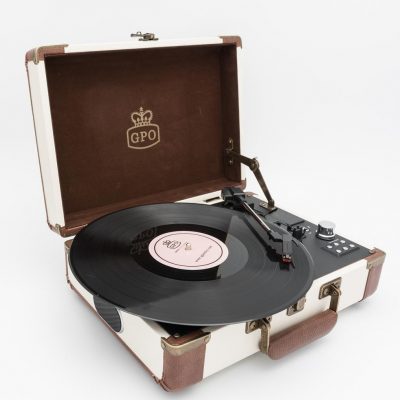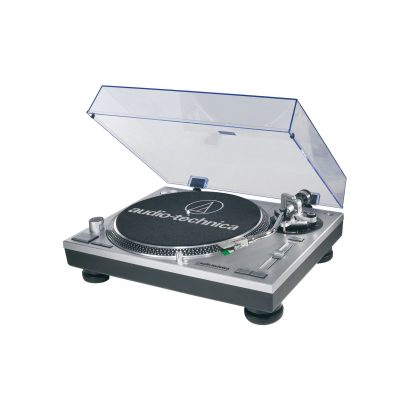We get this question a lot. Here are some tips that might be useful to you.
Get something that is within your budget.
HiFi system can be outrageously expensive. When you are just starting a new hobby, over spending can put a lot of financial strain on your life. Set aside a realistic sum for the equipment, and factor in the monthly cost of adding new records into your collection. Always stick with your budget and you will find it more enjoyable this way.
All-in-one or standalone

Mass market consumer brands such as GPO Retro and Crosley excel in producing vintage-looking, hipster-pleasing all-in-one turntables. Most of these turntables focus on mobility and ecstatic at the expense of sound quality. While it is very convenient to have built-in speakers embedded in the record player, these speakers create vibration, which affects the sound. Most low end turntables uses ceramic cartridges. The pick up sound from ceramic cartridges are harsh, a bit like the sound of 70s car radios.
If you want high fidelity sound, go with standalone turntables. Period. Don’t expect hifi quality from these.
If you like the nostalgic sound and portability is high priority, go with the all-in-one record players. You can always add external speakers to enhance the sound system. But please take note, it is not possible to upgrade the cartridges.
All-in-ones are very popular amongst teenagers and it is ok for small listening spacing, like a bedroom for example.
Direct drive or belt drive
Direct drive turntables (often called decks) have good speed stability. This is technically referred to lower wow and flutter. They allow backward playing and scratching. Traditionally, direct drive turntables are used by DJs and recording studios. The most famous direct drive turntable is the legendary Technics SL-1200.

Belt drive turntables uses a smaller motor that are usually placed away from the platter. This means less vibration. Entry level belt drive turntables tend to have inconsistencies in the speed. You also need to factor in that belts will stretched and need replacement over time.
Due to the size of the motor, direct drive turntables are usually bulkier and heavy. Both Audio Technica LP-120 and LP-5 weight around 12kg. Belt drive turntables below $1000 dollars are usually more compact, lighter (about 5kg) and features a modern look. Some comes with very nice wood veneers finishing.
Sonic performance wise, at entry level these two drive system are almost the same. Direct drive are often described as able to reproduce the music that sounds more forward, more attack, punchy and exciting. Belt drive turntables produce more laid back, balanced and easy-on-the-ear music.

Matching your sound system and expectation
It is important to make sure your analogue source, in this case the turntable, matches your sound system. Simply put, a wrongly matched system will definitely produce substandard sound. There are 4 main components of a sound system: source, stereo amplifiers, speakers, and accessories (cables, connectors, power conditionals etc)
As a guideline, we believe that one should invest in sound system in the following ratio: 30% source, 30% amplifiers, 30% speakers, and 10% accessories.
A $200 turntable will not produce satisfactory sound if you feed it to a $5000 amp + speaker system. A $1000 dollar turntable will sound lifeless if the output is connected to a pair of $200 desktop speaker.
Another important thing to note is, don’t expect a $500 turntable to sound better than a $1000 one. Reviews on magazines or blogs could have rated a lower end turntable 5-star and higher end one 4-star. This simple means that taking into consideration of the pricing point and the competing products in the same range, how good does a particular turntable fares.
Features to look out for
Let’s quickly explain a few common features that you want to consider before making final decision
- Phono pre-amp – all vinyl records need phono pre-amps. Entry level turntables often have this built-in else you have to buy an external phono pre-amp. Good audiophile turntables usually does not come with built-in phono.
- USB port – this is simply a feature to digitise your vinyl music, ie. record your vinyl to mp3 or other digital format
- Dust cover – usually made from acrylic. This is important to prevent your records and turntable from getting dusty.
- 33rpm & 45 rpm speed selector – Some belt drive turntables require users to manually flip the belt to change rpm speed. Some belt drive turntables and all direct drive turntables allows you to change rpm speed with the press of a button.
- Auto start & auto return / stop – For simplicity sake, good turntables are usually very manual. Some entry level turntables do add in the functions to start / stop vinyl playing music automatically so that in case you fall asleep halfway through playing the record, you don’t have to worry about wearing off the stylus. On a manual turntable, the platter will keep spinning even when the record has finished playing. You can also add an automatic tonearm lifter call Q UP. What it does is it lifts up the tonearm at the end of the record.
- Bluetooth – many new turntables in 2017 added in this feature to allow paring with your wireless headphone or speakers. There will be some quality lost of course, but if you hate messy wires then this is a critical feature.